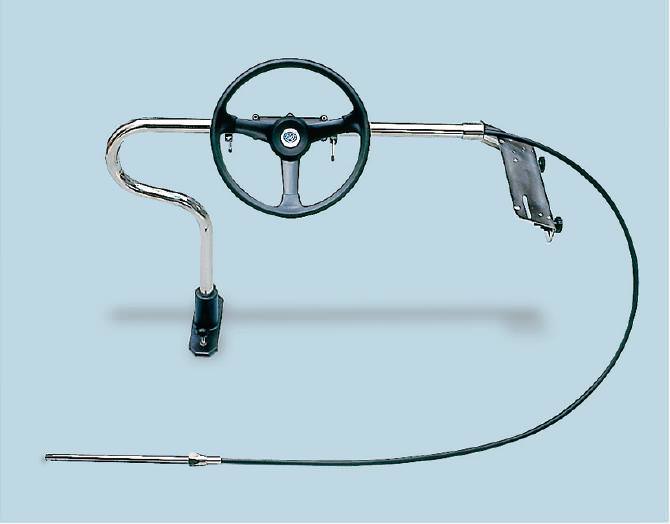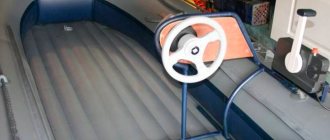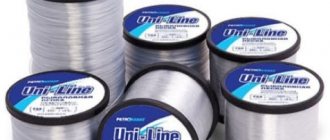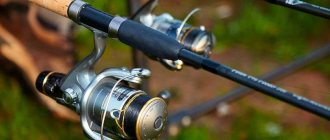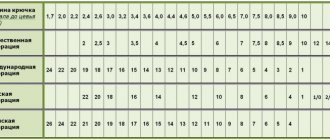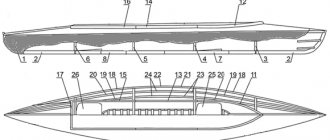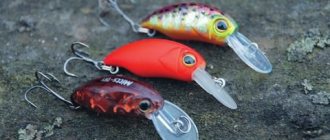PVC boat steering console
Most PVC boat owners think about how to make boat control convenient and comfortable.
The inflatable boat can be controlled remotely, that is, using the steering console or tiller. When equipping a boat with a steering wheel, you should pay attention to the following factors:
- The purchased console must correspond to the overall dimensions of the boat, as well as the physical capabilities of the owner. In addition, you need to familiarize yourself with the method of attaching the console, which is located in the cockpit area.
- Before purchasing, you need to consider the possibility of removing it if operating conditions require it. If such actions are not necessary, then you can give preference to a monolithic structure. Otherwise, the choice should be made on a collapsible structure consisting of a small number of individual elements.
- Many owners argue that the design should be lightweight and, at the same time, reliable, so that there is no excessive fuel consumption.
- The cost of the structure depends on the functionality, its strength and reliability.
Currently, it is possible to choose a suitable console model, which is due to the availability of a variety of designs from different manufacturers. Despite this, each console is equipped with a steering wheel and a reverse throttle lever, which dramatically reduces the effort required to control the boat.
Which console should you choose?
The steering console is designed to change the direction of movement of the craft. In addition, devices for various purposes can be located here, including devices for monitoring engine operation.
All elements are mounted on a special chassis, to which all motor control parts are connected. Here you can also install a tachometer, a voltmeter and a trimmer that controls the tilt angle of the outboard motor. Moreover, many owners of such structures install navigators and echo sounders on them. You can find various remote control designs depending on the design features of PVC boats. Since boats differ in size, consoles also have different sizes.
To choose the appropriate option, you need to follow some recommendations:
Purpose of a small vessel:
- for fishing or hunting;
- for tourism.
Intensity of use and range of movement.
When purchasing a console, you should study its technical characteristics in detail. For example:
- what is the advantage of this model;
- its material of manufacture;
- its overall dimensions and technical capabilities.
Regular steering console
Typical remote controls for PVC boats include devices such as:
- steering cables;
- tiller extensions;
- steering wheel gearbox;
- reverse machine with gas.
Installation of the motor remote control device is carried out before launching the motor boat into the water.
Typically, the remote control kit includes:
Outboard motor for a boat , capable of being controlled remotely.
Engine controls such as:
- wide or narrow steering console with all fasteners;
- gearbox selected for a specific type of motor and steering wheel;
- steering wheel;
- cable;
- craving;
- rod fastening element.
As a rule, the main device is considered to be a gearbox, which transforms the rotational movements of the steering wheel into translational movements of the control cable.
There are 2 types of gearboxes:
- for outboard motors with power up to 55 hp, with single gear;
- for engines more powerful than 60 hp, operating on a planetary principle.
Almost all designs have a panel made of waterproof plywood, plastic or stainless steel. It is much less common to find other options.
Mini console for PVC boat
The console is not large in size, unlike the classic console, and is perfect for installation on small inflatable boats.
The advantages of the mini design include:
- It can be installed on watercraft structures of any size.
- Lightweight and easy to install.
- The console is attached to the boat cylinders using special adapters, which are included in the mini console kit.
- It is possible to install 2-3 additional elements, such as an echo sounder, tachometer and navigator.
The mini design uses standard gearboxes:
- Gearbox G08, T67.
- T-71 FC gearbox, as well as other similar gearboxes.
It should be noted that mini consoles are also available with left-hand drive.
Dimensions of the mini console: length – 750 mm, width – 920 mm and height – 720 mm. The device is made of white or gray fiberglass and weighs up to 4 kilograms. A similar design costs from 7 to 12 thousand rubles.
It is recommended to install an element such as a rail, which will help protect the structure from damage in the presence of rough waters. In addition, headlights or other equipment necessary for operation can be installed on this element.
Types of steering on small boats
Today, steering devices for water transport are classified according to their operating principle and design features. To begin with, we suggest studying the nuances of the operation of devices of various types, and then becoming familiar with possible design variations.
Mechanical device
Installing a mechanical steering gear on a boat is the simplest and most affordable for owners of small vessels. By its design, the mechanical distance to the outboard motor consists of the following components:
- Mechanical gearbox - there are 2 types used on PLM with power up to 55 hp. and on PLM with a power of 55 - 150 hp. If the vessel has a more powerful engine, it is recommended to use hydraulics instead of a mechanical device.
- The steering cable is a metal cord with a protective plastic sheath. The length depends on the overall parameters of the vessel, and the brand is again determined by the power of the PLM. Engines up to 55 hp are equipped with M58 cables, and more powerful devices are equipped with M66 cables.
- Steering rods are fully consistent with the strength of the installed motor.
- The steering wheel is actually the control lever itself, which is attached to the steering gearbox. There are no special requirements for this part, and the key parameters are only the dimensions of the vessel and user preferences.
The remote control for a mechanical type PVC boat operates according to the following principle. Turning the steering wheel to the side causes the gearbox to move, on which a cable is wound, laid along the side of the vessel. This cable is attached to the engine using steering levers, to which the impulse is transmitted. The design also provides a number of cables of smaller diameter, through which gears are changed, speed and engine tilt angle are adjusted.
You might be interested: Put PVC on a boat: what is it, types of materials and designs, tips for choosing
Mechanical steering racks for PVC boats are attractive due to their low cost (up to 10 thousand rubles) and ease of installation. But at the same time, compared to other types, this installation is more subject to wear and tear and requires more careful maintenance.
Hydraulic steering system
Hydraulics are usually installed on ships with engines of 150 horsepower or more. For example, these could be mini-yachts and large fiberglass or aluminum boats. In this case, the design of the hydraulic system includes the following elements:
- Steering pump (oil nose);
- Hydraulic cylinder;
- Hydraulic hoses;
- Steering wheel.
The operating principle of such a device, unlike mechanics, is more complex. The steering wheel is fixed to the pump shaft, and when the steering wheel rotates, the pump sends compressed oil into the cavity of the hydraulic cylinder, which is attached to the PLM using hoses. The hydraulic cylinder is divided into 2 cavities, and when the steering wheel rotates, the pressure in one of the compartments increases, causing the piston to direct force towards the engine or steering column.
An important condition for reliable operation of hydraulics is high-quality oil that is not subject to compression and causes minimal friction. These parameters are important to eliminate backlash that interferes with the quality of signal transmission. By the way, the high accuracy of the signal ensures that the steering gear of the outboard motor is sensitive to the slightest effort. This point, coupled with reliable operation, is valued by hydraulic users. The only downside of this design is the price, which on average is about 30 thousand rubles.
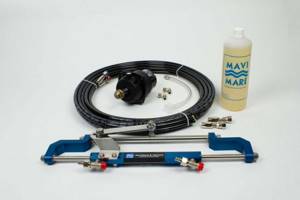
Electronic remote control for boat
At its core, electronics is not a separate type of control, but rather an option to hydraulics and mechanics. Installing electrical equipment simply helps to achieve a number of benefits, namely:
- Refusal to use cables and, as a result, increased convenience and safety of the steering system;
- Elimination of installation of cables on the gear switch;
- Possibility of unified control of several twin motors.
In general, electronics contribute to greater comfort and ease of control, but such an addition also costs a lot. On average, to buy a steering kit for a boat with electrical equipment and install the system with the help of specialists, you will need about 100-120 thousand rubles. Therefore, such a system is almost never found on small boats and motorboats. In general, in the vast majority of cases, the steering wheel for a PVC boat has a mechanical type of control, so we’ll talk about it in detail further.
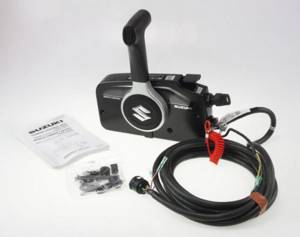
Removable steering console for PVC boat
Dimensions of the removable device: width – 530 mm, length – 510 mm and height – 510 mm. As a rule, right-sided installation is preferred, although it can also be installed on a left-handed cylinder. The structure weighs about 3 kg and can be installed on an inflatable boat in a matter of minutes.
It is characterized by the following indicators:
- Easy to install and operate, and low weight does not lead to excess fuel.
- It takes up very little usable space, which is very important when installed on small vessels.
- Resistant to mechanical forces and behaves well during movement.
The removable structure is attached using special glued adapters and a plastic heel that rests on the floor. It has rounded shapes, which reduces the risk of injury or damage to inflatable parts.
TOP 7 best PVC boat steering consoles
In specialized stores you can find various design solutions for remote control systems for outboard motors. But among them there are better offers:
Deck console, narrow
Its cost is within 18 thousand rubles.
Main technical characteristics:
- Available in gray or white.
- Manufacturing material – fiberglass.
- Overall dimensions of the console: length – 80 cm, width – 50 cm, height – 115 cm.
Wide steering console with glass and deck mount
This design is estimated at 18.9 thousand rubles.
Main technical indicators:
- Available in white or grey.
- Manufacturing material – fiberglass.
- There is protective glass and a protective handrail.
- Dimensions of the device: length – 90 cm, width – 60 cm and height – 110 cm.
Steering column made of stainless steel “Compact”
The stand is made of pipe with a diameter of 25 mm and is estimated at 9.9 thousand rubles. The design is capable of working with T85, G10, G12 or T67 gearboxes. On the right side there is a reverse and gas machine. The kit also includes fastening elements.
Small steering rack with mounting for 2 cylinders
The stand is designed for installation on PVC boats. The material used for its manufacture is stainless steel pipe. The device is attached using special eyelets that are glued to inflatable structures. Mounting elements are supplied with the stand. The steering rack can work with any gearbox. A reverse and gas controller is also installed here. Installation instructions can be found in the kit.
The product costs 8.9 thousand rubles.
Stainless steel steering column with mounting for one cylinder
This is a popular type of console because it saves usable space. Any steering gearbox and reverse and throttle controller can be installed on the rack. Fastening elements are also supplied with the product. The device costs 5.95 thousand rubles.
Mini steering console
A similar design costs 11.45 thousand rubles.
Main characteristics of the product:
- Color white or grey.
- Construction material – fiberglass.
- Mounts for cylinders with a diameter of up to 55 cm.
- It is possible to install a steering wheel, gearbox and reverse throttle controller on the console, which are purchased separately.
- Design dimensions: length – 530 mm, width – 540 mm and height – 470 mm. Product weight – 2.5 kg.
Plastic steering console with seat
It is installed on the right side and has the following dimensions: length – 50-59 cm, width – 59-65 cm and height – 48-56 cm. The kit includes a seat with a height of 44-48 cm. The weight of the product is 65 kg. The cost of such a design is estimated at 55 thousand rubles.
When purchasing a product, you should always check the package contents. Almost every product must have installation and operating instructions.
Top best models
The ranking of the best steering systems includes:
- narrow and wide console;
- stainless steel stand;
- console complemented with a seat;
- compact steering rack mounted on cylinders;
- “Sport” console with protective glass;
- design for inflatable boats made of polyvinyl chloride and models with a rigid structure (RIB).
The narrow deck console is made of fiberglass and is characterized by compact dimensions, budget cost, and durability. The product is suitable for small PVC watercraft. The model reaches 80 cm in length, 115 cm in height, and 50 cm in width. The design is equipped with a windshield. Installation of a safety handrail is available.
The steering console is wide with glass and deck mount, made of fiberglass, equipped with a protective handrail. The model is designed for medium-sized watercraft equipped with outboard engines. The console measures 0.9 cm in length, 0.6 m in width, and 1.1 m in height.
The “Compact” stainless steel steering post is a durable, wear-resistant structure designed for remote control of a PVC vessel. The model is constructed from pipes with a diameter of 20−25 mm. The product is suitable for use with gearboxes G12, G10, T67. The right side of the rack is reserved for the reverse and gas machine. The packaging includes fastening elements (nuts, clamps, cable).
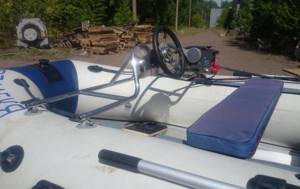
The steering rack, designed to attach to 2 PVC flotation tanks, is made of stainless steel. The design is designed to work with different models of gearboxes. The throttle and reverse controller is fixed on the rack. On the ship, the product is secured using an eye, which is fixed to the structure. The kit includes fasteners and waterproof adhesive.
For compact boats, it is optimal to use a rack that is attached to 1 cylinder. The device is ergonomic and saves space on the boat. The model is universal, because Suitable for various gearboxes and engine power regulators. The kit includes fastening elements (screws, cable). The model is distinguished by its affordable price, low weight, and durability.
The plastic console, complemented by a seat for the driver, is compact, ergonomic, and stable. The structure is fixed on the starboard side of the vessel. The console reaches a length of 0.5−0.6 m, a width of 0.6−0.65 m, a height of 0.48−0.56 m. The design is equipped with a seat up to 44−48 cm high, which is attached to the transom support installed on the ship's frame. The weight of the product is 5 kg. The kit includes fastenings, cable, instructions.
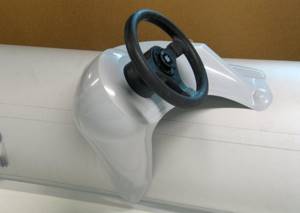
The “Sport” mini console is made of fiberglass and complemented with protective glass. The design is stable, reliable, recommended for watercraft with a length of more than 390 cm. The weight of the product is about 5.5 kg. The supports are fastened to the vessel's cylinder using eyelets and screws. The console measures 64 cm in length, 80 cm in width, and 67 cm in height.
The dimensions of the console allow you to attach and use navigation systems, echo sounders, sensors, and speed control devices. The design is intended for boats with cylinders reaching 42−60 cm in diameter. The product is equipped with a windshield, eye, nuts, and screws for mounting on a boat. The console is suitable for different models of mechanical gearboxes.
The complex for remote control of boats with a YAMAHA 9.9 engine is fully equipped. The design is durable, strong, versatile, because... also designed to control 15 hp outboard engines. with similar technical characteristics.
The kit includes a console made of transparent plastic, a T-67 gearbox, a steering wheel with a diameter of 325 mm, 2 M-58 cables 3-6 m long. The design is equipped with sensors, a gear switch (B-47 or B-49), adapters, reverse and throttle valve, steering lever, set of fittings, nuts.
Installation of steering console for PVC boat
As a rule, this does not require much effort, but some factors need to be paid attention to. For example:
- It is better to mount the device in the middle of the length of the boat in order to balance the reactive component of the propeller.
- Before the installation process, you should take into account the strength of the boat motor.
- The power of the gearbox should always match the power of the motor. For example, the T67 gearbox is designed to work with a 60 hp motor.
- Accordingly, a cable should be selected for this pair, for example, brand T09 or M58.
- For such elements, you should select a steering wheel of the appropriate diameter, for example, no more than 400 mm.
If a motor with a power of 60-110 hp is used, then a T71 gearbox should be installed. This gearbox does not require additional configuration. In addition, it is made of duralumin and is not afraid of mechanical stress.
The T85 gearbox is designed for steering structures operating in tandem with engines with power up to 160 hp.
Device characteristics:
- Stroke 220 mm.
- The steering wheel makes 3 turns until it locks.
- The device is designed for a force of up to 350 kg.
- The permissible minimum bend of the M66 cable is 200 mm.
How to install and connect the steering control to a boat and boat to control an outboard motor
The steering installation method does not depend on which side the cable is laid on! Left side or starboard - it's up to you. Lay it out as you see fit.
Note! Before laying the steering cable, you MUST know the characteristics of the steering gear! Most steering gears allow the cable to be routed along any side, but some only RIGHT or only LEFT.
To select, install and connect the steering to a boat or boat, it is necessary to prepare an outboard motor (BOM) to attach the steering mechanism to it. If the outboard motor was equipped with a “remote control”, then it is ready for installation of a steering remote control. But it often happens that we have a tiller motor and we want to put a distance on it. To do this, we need to do a number of preparatory work.
When to install a steering wheel for a boat
First of all, let's talk about whether it is necessary to buy a steering wheel for a boat or for a boat. And here I would immediately like to note that the legislation does not put forward any mandatory requirements at this point. Of course, if the design of the watercraft is initially equipped with a helmsman, then the owner is obliged to maintain it in stable working condition. But today we are looking at a different situation: when a regular boat or boat is purchased, and the owner wants to install a remote control for the outboard motor. In this case, there are several objective reasons for buying a helmsman:
- Long journeys – sitting half-turned “in an embrace” with the PLM is not the best way to spend a long boat trip. The muscles will quickly become numb, steering the boat will become uncomfortable and the sensations from the trip will clearly not be the most positive.
- A large vessel - manual control for PVC boats up to 3.5 meters can still be called relevant and convenient, but for watercraft with a hull length of 4 meters or more, such movement control can already become unsafe. The fact is that due to the large distance, forward visibility deteriorates, and if at the same time the ship also has an excessive stern trim, then visibility will be greatly reduced.
- The nature of the use of the watercraft - this point refers to the purpose of purchasing the boat and the operating conditions. For example, it is convenient for a fisherman to control a PVC boat via remote control due to the fact that at any time he can free his hands for the fishing rod and be confident in full control of the movement of the craft. For lovers of boating, a steering wheel is necessary for confident and comfortable control of the vessel.
- Comfort – if the dimensions of the vessel and financial capabilities allow, then why not provide your boat with the ability to control it remotely. Without a doubt, this option will contribute to more comfortable and safe trips to the water.
Here are the main reasons for purchasing a remote control for small boats. And now we propose to consider how a remote steering device for a motor boat or boat is designed and on what principle it works.
1.Preparing the tiller outboard motor for connecting the steering control.
If the motor is a tiller motor, then in order to connect a remote steering control to it, it must be converted. Most motor manufacturers offer ready-made kits for converting the PLM into a steering remote control. Often, instead of a ready-made kit, the manufacturer allows the owner of the motor to independently determine the need for components. a mounting plate on the outboard motor , to which the steering rod , which must be purchased, will cling. Next, you need to make sure that there is a place for attaching the cable jacket on the motor. As a rule, outboard motors are equipped with a special pipe located in the area of the clamps that attach the motor to the transom. If there is no such pipe on the motor, then a transom support for the steering cable (it comes in a simple version or complete with a transom pad).
Steering remote control connection kit:
— mounting plate in the amount of 1 pc. (if there is no special hole on the motor)
— steering rod in the amount of 1 pc.
— steering rod for two motors in the amount of 1 pc. (if you plan to connect two PLMs or an additional hanger)
— transom steering cable support in the amount of 1 pc. (if there is no special pipe for connecting the cable)
So, everything is ready on the motor side. What's left to do?
3. Select, buy and connect the steering control to the boat.
Note! Before purchasing a steering cable, BE SURE to calculate its length, study the classification of steering cables and check the compatibility of the cable with the steering gearbox! Before purchasing a steering gear, study its characteristics - what cable is intended for it, the number of revolutions to fully shift the steering wheel, shaft length, dimensions.
The complete composition of the steering kit for a boat or boat:
— steering cable in the amount of 1 pc.
— steering rod in the amount of 1 pc.
— steering rod for two motors in the amount of 1 pc. (if you plan to connect two PLMs or an additional hanger)
— transom steering cable support in the amount of 1 pc. (if there is no special pipe for connecting the cable)
Sequence of assembly and connection of the steering control.
There is nothing complicated in assembling and connecting the steering remote control, even a schoolboy can handle it: - insert the cable into the steering gearbox ( DO NOT FORGET TO LUBRICATE IT BEFORE! ) - lightly throw the steering wheel onto the gearbox shaft and pull the cable inside the gearbox by turning the steering wheel ( DO NOT Tighten the steering wheel! ) - fasten the cable jacket to the gearbox - install a special plate from the fastening kit for the steering gearbox on the console - remove the steering wheel from the steering gearbox, fasten the gearbox to the plate and lay the cable in the boat - putting the steering wheel on the gearbox, rotate it and ensure that the steering cable rod got out exactly half way ( DO NOT Tighten the steering wheel! ) - check the alignment of the steering wheel (if the steering wheel is in the center, skip the next step)
Steering wheel alignment . There will be a guide soon.
— insert the cable rod into the pipe or transom support and fasten the jacket with a nut — cling to the motor (if a steering rod is used, then adjust its length without moving the steering cable rod from the previously set position) — by rotating the steering wheel left and right, check that the MOTOR ROTATES IN THE REQUIRED SIDE! If when you turn the steering wheel to the left, the motor turns the other way to the right, then the steering cable is not inserted into the gearbox correctly! We take out the cable from the steering gearbox and insert it into the adjacent hole. Then we again check the correct rotation of the motor. - if everything is done correctly, then remove the steering wheel from the gearbox, attach a decorative trim to the console, putting it on the gearbox shaft - put the steering wheel on the gearbox shaft and ONLY AT THE VERY END RELIABLY TIGHTEN THE STEERING WHEEL WITH A NUT!
The steering system has been selected, installed and connected! All that remains is to take a comfortable seat and enjoy the work done!
Examples of completed work.
Almost installed a new steering wheel in the boat.
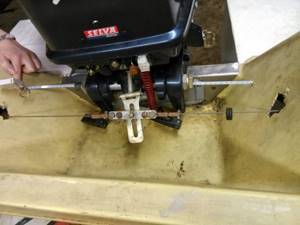
In general, there was an old Soviet steering system, described in Boats and Yachts, probably back in the 60s. The point is that there is a cable running around the cockpit of the boat, on rollers, which is rewound along the steering shaft, like a window lifter, and at the back, it clings to the engine. It's certainly better than a tiller, but...
The cable is long and must be tensioned; the rollers do not have bearings. All this spins quite tightly, creaks, transmits quite a lot of back force from the motor and, most importantly, has a huge total backlash. Under load, almost a quarter turn!
At the end of August, I tried to steer a boat with normal, modern steering, and realized that something needed to be done.
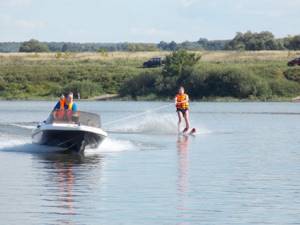
There is practically no play, the steering precision was simply amazing, the boat reacts no worse than a car. I rode mine. Hand-letso.
The difficulty was that modern steering systems are very bulky, and the sub-engine niche (recess) was not designed for a modern steering wheel. It's too narrow.
The option of installing a cable support at the edge of the recess was also not suitable - firstly, the pushing and pulling force (up to 120 kg, by the way!) should be absorbed by the wall of the recess, and I have a thin one, secondly, the width of the body is small, and if you install the cable is on the edge, there is no room for a smooth bend. In a word - an ambush on an ambush.
As a result, it was decided to install a new steering wheel, with the cable resting on the engine frame and cutting a huge hole in the recess for the thrust.
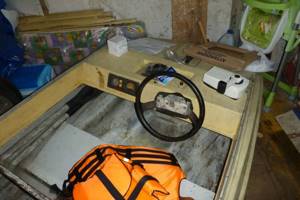
It became after the 1st modification for a quick-release steering wheel (the controls themselves remained unchanged):
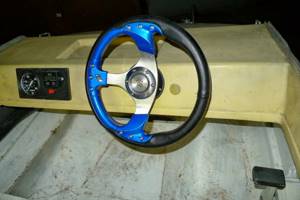
The covered hole is the result of unsuccessful positioning of the steering wheel; my dad did this at the manufacturing stage. If the steering wheel had been small back then, nothing would have happened, but the Moskvich steering wheel is huge.
In order to dock Selva to the existing helmsman, it was ordered at a helicopter factory for crazy thousands, this is the language:
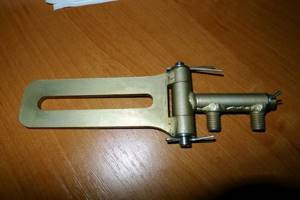
Why the hell did I order it - idk, I should have installed a normal steering wheel right away.
So here's the system:
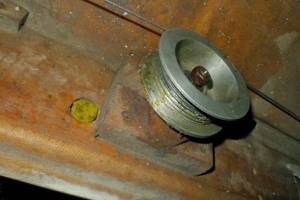
Replaced with modern one:
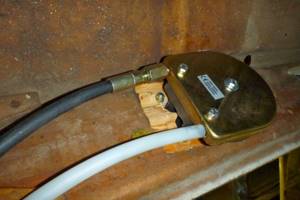
I just hesitated to cut it out.
Now, it looks like this (don’t look at the steering wheel, I took the cheapest one, if I get rich, I’ll change it):
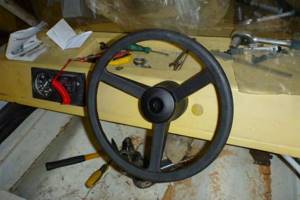
And from the motor side:
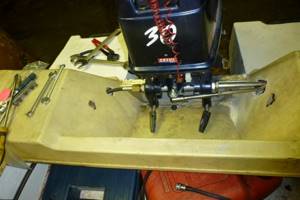
The hole in the part where the thrust goes needs to be expanded further, but not by much. I'm thinking of gluing a glass in there so it won't be so terrible. I will seal the holes from the old cable.
Well, I did the glazing, it seems okay:
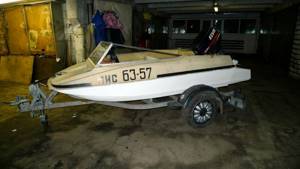
All that remains for the steering wheel is to put the boot on the cable, widen the hole for the rod (it rests when the engine is tilted), seal the extra holes in the recess, and secure the steering cable.
Well, in general, for expensive things, you need to find and install a mounting beam, and sew a shipping cover so that water does not spill into the cabin during transportation and parking. I still need to do something to make the speedometer work, install a pitot tube and a hose, I’m thinking about electrics - installing a generator on the engine, and a tachometer and side lights on the boat. Now there is a tachometer, but it is battery-powered, digital, and even glitches at high speeds. There are no electrics at all. The old buoyancy blocks, either made from polyurethane foam or something else, have crumbled into rubbish, you need to buy polystyrene foam and cut and glue the blocks from it. Well, paint it, of course, but that’s clearly not this season.
Why do you need a steering console for PVC boats?
You can maneuver the PVC boat using a tiller or remote steering. It is attached to the ship and consists of a steering wheel, a stand, a gearbox and a gear selector.
There is a place for installing a stationary echo sounder with GPS, and this ensures the safety of passengers during long journeys, hunting and fishing.
Additional devices are conveniently placed:
- tachometer to determine engine speed; voltmeter for measuring voltage in the power supply system;
- trimeter to control the angle of the motor.
How to make a steering console with your own hands?
It is not always possible to purchase suitable devices in stores. Yes, and they are quite expensive. Therefore, many shipowners make them themselves, making them from marine plywood. It is better to make the width at least 45 cm in order to place the battery at the bottom and leave room for the captain’s legs. The sharp edges of the structure are carefully cleaned to avoid injury.
Before starting work, they buy the necessary parts and components: steering wheel, gearbox, reverse and throttle controller, engine control devices. You immediately need to think about how the control devices will be located on the panel: steering wheel, tachometer, voltmeter, trimeter, echo sounder.
The work is carried out in the following order:
- All parts are cut out of marine plywood and fastened together with furniture corners.
- Epoxy glue is used to lubricate all joints and end surfaces.
- A hole is cut out on the dashboard for the steering gear.
- All instruments and switches are placed on the panel.
- The entire stand is covered with fiberglass, followed by application of a primer.
- After drying, apply waterproof paint.
- The structure is secured to the boat with screws.
Types of steering consoles
These devices come in different sizes and are made using different materials. They also differ in operational parameters. All parts are mounted on a panel to which the motorboat control parts are connected. There are three main types of devices.
Regular steering console

A typical remote control system includes: control cables, steering gear and throttle and reverse controller. Before using the boat, it must be inflated with air and the installation of the necessary attachments must begin.
Typically it includes:
- Outboard motor;
- Steering console;
- Gearbox;
- Steering wheel;
- Cable;
- Traction;
- Fastening elements.
One of the most important and complex parts of a remote control system is the mechanism that converts rotational movements into linear movements of the actuator.
The following gearboxes are used:
- 1:1 gearbox for outboard motors up to 60 hp;
- Gearbox with planetary transmission principle for motors with a power of more than 60 hp.
How to catch more fish?
For motors with power up to 60 hp. a T-67 gearbox with a steering wheel diameter of no more than 40 cm is installed. For a motor with a power of more than 60 hp. The T-71 gearbox is installed. This gearbox is made of silumin, very durable and wear-resistant.
Mini steering console

From the name it is clear that it has small dimensions: 48 * 51 * 43 cm. It is convenient and easy to install on any compact PVC watercraft. It is quite light: from 2.8 to 4 kg.
It is secured to the motorboat using individual fasteners, usually included with the device. Additional space is provided for installing a tachometer, echo sounder and other instruments.
Removable model
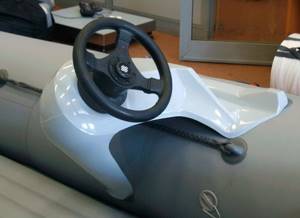
The removable remote control system is made of fiberglass, so it is lightweight, no more than 3 kg. It is easy to install. It is easy to lift and transport.
The design is durable, does not vibrate while moving, is attached to the boat using glued adapters and rests on the floor with a rounded plastic support, which eliminates the possibility of damage to the bottom and injury to the shipowner.
Steering cable selection
The steering cable is an important console control element and is located on the right or left side. In ships, 2 cables are required, which are used to regulate the gas and shift the gearbox.
Several types of cables and fastenings have been developed. When selecting a product, it is important to determine the dimensions (length, thickness) and technical characteristics. When calculating the dimensions of the cable, the distance from the central part of the gearbox to the side of the boat, the length of the side and the transom are taken into account. For 90° bends, an additional 100 mm must be taken into account. It is necessary to add 30.5−30.7 cm to the results obtained.
The cable marking is selected in accordance with the gearbox model. For T-67 steering gears with a motor power of 55 hp. a cable marked M58 is required. The fastening is thin, plastic, comfortable to use, inexpensive, but not wear-resistant enough.
For driving the steering T-85 and a motor with a power of 55 hp or more. M66 cable is required. The fastening is strong, wear-resistant, and has a large diameter.
Engines operating at high power require the vessel to be equipped with hydraulic steering systems. The devices support smooth movement and easy change of direction of the craft.
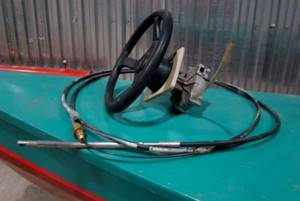
Tips for choosing a device
- When choosing the best equipment for your motor boat, you should take into account the purpose for which it was purchased: for walking and traveling or for fishing and hunting.
- It is of great importance how often the boat will be used and what distances it will travel.
- It is necessary to carefully review in full the materials presented by the seller about what types of remote control systems there are and what they are made of. Plastic, for example, is very smooth and less brittle than fiberglass. Metal is the most durable material. Marine plywood is waterproof.
- Size and weight are very important. These parameters are selected according to the size of the boat. If the equipment will have to be removed frequently, it should be removable, lightweight and have a convenient fastening. If there is no such need, then it is better to purchase a monolithic structure. In this case, more fuel will be consumed, and such equipment will cost more.
- It is advisable to install a railing. Lighting devices and any other equipment needed on the water are attached to it. Railing makes it possible to avoid deformation of the device during rolling.
Design features of mechanical steering for boats
As already noted, in addition to the principle of operation, steering consoles are also distinguished by design aspects. And first of all, boat steering kits should be divided into stationary and mobile.
Stationary installations most often represent non-removable panels, on which, in addition to the steering wheel, a whole set of navigation instruments and necessary electronics is located. Among other things, such a console may contain a tachometer, echo sounder, voltmeter, navigator, etc. However, only owners of fairly large boats and boats (minimum 3.5 - 4 meters in length) can afford such an installation.
The mobile steering control for a PVC boat, in turn, is characterized by its compact size and the ability to quickly dismantle the device. For example, if you plan to go out on the water for a short time and there is no need for a steering wheel, then you can easily remove it and leave it for storage in your car or garage. And due to its dimensions, such a console does not take up much space on the vessel’s cockpit, which is why this type of helmsman is preferred by owners of small boats.
In addition to dividing into mobile and stationary installations, remote control of a boat motor is also classified by type of construction material. And here we can distinguish the following varieties:
- The plastic console is the lightest and simplest installation in design. It has a smooth surface and is resistant to breakage, but frequent contact with water can have a negative impact on the appearance of the installation.
- Fiberglass is a more massive, but less durable structure.
- Plywood panel – installation with lightweight weight and a special moisture-resistant coating.
- The metal installation is highly wear-resistant, but also heavy. In most cases, metal steering racks for PVC boats are made of stainless steel.
It is also worth noting that within the same design, the manufacturer may well combine various materials, for example, plywood + metal or fiberglass + metal. This is done to increase strength and at the same time reduce the massiveness of the structure.
And finally, we will also mention such design details as the dimensions and method of attaching the steering wheel. As for the dimensions, today on the market you can find remote control of a boat engine for a small vessel of any type. So, if you own a PVC boat 2-2.5 meters long, then the ideal option would be a narrow steering wheel made of plastic or stainless steel with dimensions of half a meter wide, 50-80 cm long and 1.2 meters high. Such a console may simply contain one steering wheel, or it may also have mounts for additional devices and splash protection in the form of a small side glass.
On large vessels it is already possible to install a full-fledged steering console with a special chassis for other electrical devices. This option is usually made of plywood, fiberglass and metal fasteners. In addition, there are even options for plastic steering consoles with a boat seat attached to the structure. This installation provides greater comfort on board the ship, but is characterized by high cost and demands on the spacious cockpit of the boat or boat.
You might be interested: Choosing glue for PVC boats - a review of the best products
As for the methods of mounting steering columns, we will highlight only the right-hand and left-hand types of fastenings. Most often, owners prefer to install the steering wheel on the right side, but there is no difficulty in attaching the remote control for PVC boats or speedboats to the left side of the vessel. Actually, it’s worth talking about installation issues in more detail, so we’ll devote a separate section to this topic.
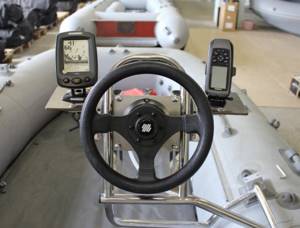
How to install a steering console on a PVC boat?
You can begin installing the remote system immediately if the engine is included in the kit. If the engine is a tiller engine, it will have to be modified. For this purpose, it is logical to purchase a ready-made kit, but you can also select the necessary parts yourself.
We buy a mounting plate and install it on the engine. We also gain traction. We check whether the engine has a socket for connecting the cable. If not, then we buy a transom cable support. Let's move on to connecting the controls.
This can be done in two ways:
- Connecting the cable through the rod.
- Connecting the cable through the transom support with an adapter.
In the first case, the cable jacket is attached to the motor pipe or transom support using a nut. The rod will go through the pipe and come out the other side.
At the end of the steering cable there is an eye to which the rod and motor are connected. The engine, which provides for remote connection, has all the necessary devices, and the tiller engine is being finalized.
In the second case, the cable will have to be routed along the hull of the motorboat and the transom support will have to be mounted on the side of the engine. There is no need for traction. We install the cable adapter. It is necessary so that when the engine turns, the angle of approach of the cable changes, providing some freedom to the power unit.
Installation of the remote control is carried out in the following sequence:
- Lubricate the cable;
- We stretch the cable from the rack to the motor;
- We insert the steering wheel onto the shaft and pull the cable through the gearbox, turning the steering wheel (we do not secure the steering wheel);
- We fix the shirt in the gearbox;
- Install the plate from the gearbox kit on the stand;
- Remove the wheel and install the gearbox on the rack;
- We place the steering wheel on the gearbox and rotate it until the steering cable reaches half the stroke (we do not secure the steering wheel);
- Place the steering wheel in a comfortable position and make marks on the shaft and wheel;
- We pass the cable rod through the pipe or transom support and fasten the jacket with a nut;
- We attach the rod to the motor, having previously adjusted the steering rod in length;
- By turning the wheel, we check the synchronism of the engine rotation;
- If rotation is observed opposite to the rotation of the steering wheel, then the steering wheel is installed incorrectly in the gearbox. In this case, we reinstall the cable into the adjacent hole of the gearbox;
- If everything moves in the right direction, take out the steering wheel and install a decorative ring, inserting it on top of the gearbox shaft;
- We fasten the steering wheel with a nut.
Electric steering
The complex of instruments and mechanisms under consideration is more of an addition to the two systems described above than an independent steering control. Therefore, it would be logical to simply go through the main points of the symbiosis of these three systems.
- the main advantage of this system is the ability to abandon partial or even complete use of cables;
- the control panel and the engine are connected to each other only by a cable that transmits electrical signals to the electric motors installed on the engine, and they drive the pistons of the hydraulic cylinders;
- the electrical system also makes it possible to eliminate the installation of cables on the gear switches and gas/reverse;
- If a ship has twin engines, the electrical system is the only way to control them synchronously.
